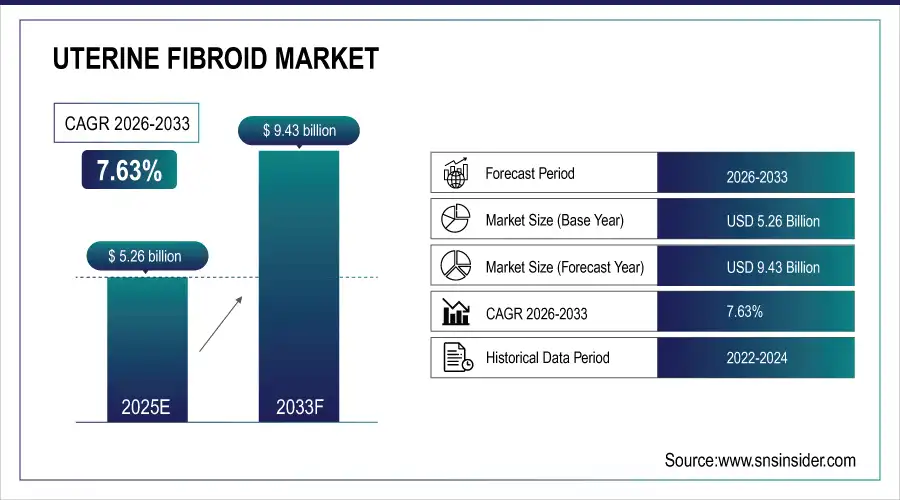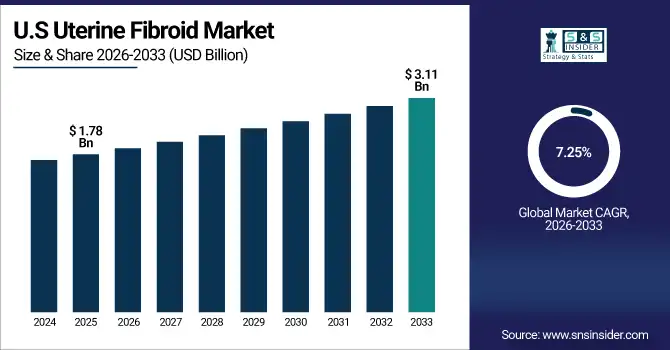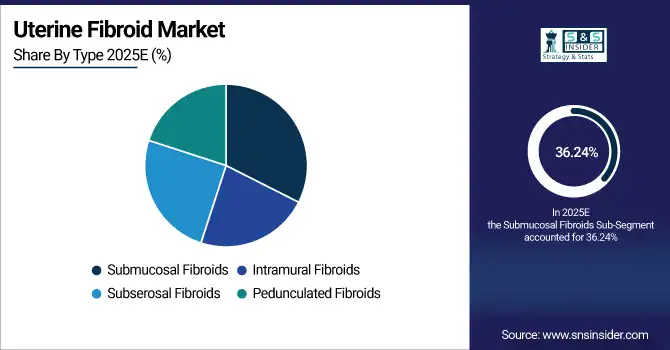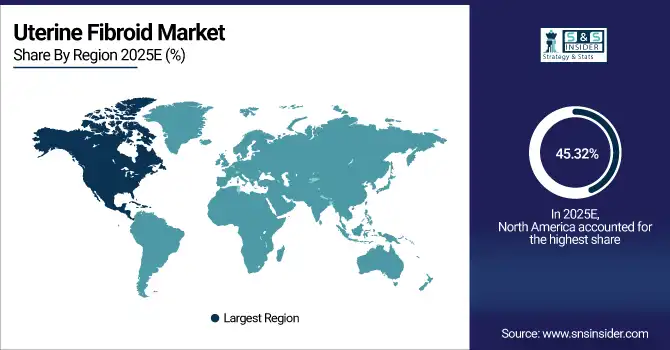Uterine Fibroid Market Report Scope & Overview:
The Uterine Fibroid Market size was valued at USD 5.26 Billion in 2025E and is projected to reach USD 9.43 Billion by 2033, growing at a CAGR of 7.63% during 2026-2033.
The Uterine Fibroid Market is growing due to rising prevalence of uterine fibroids, increasing awareness of treatment options, advancements in minimally invasive technologies, and growing demand for uterus-preserving procedures. Expanding healthcare infrastructure, favorable government initiatives, and rising investments in research and development further drive market growth globally.

To Get more information On Uterine Fibroid Market - Request Free Sample Report
Key Uterine Fibroid Market Trends
-
Increasing prevalence of uterine fibroids among women of reproductive age is driving demand for advanced treatment options.
-
Growing adoption of minimally invasive and uterus-preserving procedures such as MRgFUS, laparoscopic surgery, and radiofrequency ablation.
-
Expansion of healthcare infrastructure and availability of advanced diagnostic tools, especially in emerging economies.
-
Rising focus on personalized medicine and targeted therapies to improve treatment efficacy and patient outcomes.
-
Greater adoption of outpatient and ambulatory surgical procedures, supported by health awareness campaigns and industry collaborations.
The U.S. Uterine Fibroid Market size was valued at USD 1.78 Billion in 2025E and is projected to reach USD 3.11 Billion by 2033, growing at a CAGR of 7.25% during 2026-2033. The U.S. Uterine Fibroid Market is growing due to rising fibroid prevalence, advanced healthcare infrastructure, increasing adoption of minimally invasive treatments, growing patient awareness, and supportive government initiatives promoting women’s health and access to innovative fibroid management solutions.

Uterine Fibroid Market Growth Drivers:
-
Rising Prevalence Technological Advances and Healthcare Expansion Drive Growth in Global Uterine Fibroid Market
The global uterine fibroid market is primarily driven by the increasing prevalence of uterine fibroids among women of reproductive age, heightened awareness about gynecological health, and rising demand for minimally invasive and uterus-preserving treatments. Technological advancements such as MRI-guided focused ultrasound (MRgFUS), laparoscopic surgery, and radiofrequency ablation have enhanced treatment efficacy, reduced recovery times, and improved patient outcomes. Additionally, the expansion of healthcare infrastructure, particularly in emerging economies, coupled with growing investments in research and development, is fueling market growth. Increasing availability of advanced diagnostic tools further supports early detection and effective management of uterine fibroids.
In 2024, over 150,000 patients worldwide received MRgFUS treatment, marking a significant advancement in non-invasive fibroid therapy.
Uterine Fibroid Market Restraints:
- Limited Awareness Specialist Shortages and Regulatory Challenges Restrain Global Uterine Fibroid Market Growth
Key restraints for the global uterine fibroid market include limited awareness in rural regions, lack of trained specialists for advanced procedures, regulatory hurdles for new technologies, variability in treatment accessibility across regions, and cultural stigma around gynecological conditions. These factors can slow adoption despite technological advancements.
Uterine Fibroid Market Opportunities:
- Outpatient Procedures Personalized Medicine and Emerging Market Expansion Drive Uterine Fibroid Market Opportunities
The market presents significant opportunities through the growing adoption of outpatient and ambulatory surgical procedures, which offer reduced costs and convenience for patients. Rising focus on personalized medicine and targeted therapies for fibroid treatment is creating avenues for innovation. Expansion in emerging markets, rising health awareness campaigns, and collaborations between healthcare providers and technology developers further strengthen growth prospects for the global uterine fibroid market.
In 2024, UFE procedures experienced a 25% increase in the number of treatments performed, attributed to growing patient preference for minimally invasive, outpatient options.
Uterine Fibroid Market Segment Analysis
-
By Type, Submucosal Fibroids dominated with 36.24% in 2025E, and Intramural Fibroids is expected to grow at the fastest CAGR of 8.20% from 2026 to 2033.
-
By Treatment Type, Surgical Procedures dominated with 38.45% in 2025E, and Minimally Invasive Procedures is expected to grow at the fastest CAGR of 8.63% from 2026 to 2033.
-
By Technology, Laparoscopic Surgery dominated with 36.58% in 2025E, and MRI-Guided Focused Ultrasound (MRgFUS) is expected to grow at the fastest CAGR of 8.83% from 2026 to 2033.
-
By End-User, Hospitals & Clinics dominated with 47.49% in 2025E, and Ambulatory Surgical Centers is expected to grow at the fastest CAGR of 8.43% from 2026 to 2033.
By Type, Submucosal Fibroids Lead 2025 Market Growth Intramural Fibroids Poised for Fastest Expansion
Submucosal Fibroids are expected to dominate the Uterine Fibroid Market in 2025 due to their high prevalence and significant symptom severity, driving greater demand for treatment. Intramural Fibroids are projected to grow at the fastest CAGR from 2026–2033, driven by rising detection rates through advanced diagnostics, increasing awareness, and growing adoption of minimally invasive and uterus-preserving treatments. Technological advancements and expanding healthcare access will further accelerate growth in this segment over the forecast period.

By Treatment Type, Surgical Procedures Lead 2025 Uterine Fibroid Market Minimally Invasive Options Set for Rapid Growth
Surgical Procedures are expected to dominate the Uterine Fibroid Market in 2025 due to their proven effectiveness, widespread availability, and established clinical use, particularly hysterectomy and myomectomy. Minimally Invasive Procedures are projected to grow at the fastest CAGR from 2026–2033, driven by advancements in technology, shorter recovery times, reduced complications, and increasing patient preference for less invasive options. Rising awareness and expanding healthcare infrastructure will further fuel growth in this segment during the forecast period.
By Technology, Laparoscopic Surgery Dominates 2025 Uterine Fibroid Market MRgFUS Poised for Significant Future Growth
Laparoscopic Surgery is expected to dominate the Uterine Fibroid Market in 2025 due to its widespread adoption, proven safety, and effectiveness in treating fibroids with minimal invasiveness. MRI-Guided Focused Ultrasound (MRgFUS) is projected to grow at the fastest CAGR from 2026–2033, driven by advancements in imaging technology, growing demand for non-invasive treatments, and increasing patient preference for uterus-preserving procedures, making it a highly promising segment in the market’s future growth.
By End-User, Hospitals Leading 2025 Uterine Fibroid Care Ambulatory Centers Set for Rapid Future Growth
Hospitals & Clinics are expected to dominate the Uterine Fibroid Market in 2025 due to their advanced infrastructure, availability of specialized gynecological care, and capability to perform complex procedures. Ambulatory Surgical Centers are projected to grow at the fastest CAGR from 2026–2033, driven by rising demand for cost-effective, convenient, and outpatient treatment options. Their growth is supported by technological advancements, shorter recovery times, and increasing patient preference for minimally invasive procedures, boosting adoption in this segment globally.
Uterine Fibroid Market Report Analysis
North America Uterine Fibroid Market Insights
North America is expected to dominate the Uterine Fibroid Market in 2025 with a 45.32% share, driven by advanced healthcare infrastructure, high awareness of women’s health issues, and widespread availability of innovative treatment options. The region benefits from strong investments in research and development, advanced diagnostic tools, and the adoption of minimally invasive procedures. Rising prevalence of uterine fibroids, supportive government initiatives, and well-established healthcare systems further strengthen North America’s leading position in the global uterine fibroid market.

Get Customized Report as per Your Business Requirement - Enquiry Now
U.S. Uterine Fibroid Market Insights
The U.S. dominates the North American uterine fibroid market due to advanced healthcare infrastructure, high adoption of innovative treatments, extensive research funding, widespread awareness of women’s health, and strong access to skilled specialists and advanced diagnostic technologies.
Asia Pacific Uterine Fibroid Market Insights
Asia Pacific is expected to grow at the fastest CAGR from 2026–2033 in the Uterine Fibroid Market, driven by rising healthcare access, growing awareness of women’s health, and increasing adoption of advanced treatment technologies. Expanding healthcare infrastructure in countries like China and India, coupled with a large patient population and supportive government initiatives, will fuel market growth. Additionally, rising investments in medical research and expanding outpatient treatment facilities will further accelerate the region’s market expansion.
China Uterine Fibroid Market Insights
China dominates the Asia Pacific uterine fibroid market due to its large patient population, rapid healthcare infrastructure expansion, increasing awareness of women’s health, growing adoption of advanced treatment technologies, and strong government initiatives supporting access to modern gynecological care.
Europe Uterine Fibroid Market Insights
Europe is projected to hold a 24.64% share of the Uterine Fibroid Market in 2025, driven by advanced healthcare infrastructure, high awareness of women’s health, and widespread availability of innovative treatment options. Strong adoption of minimally invasive procedures, ongoing technological advancements, and well-established healthcare systems contribute to market growth. Supportive government policies, rising investments in medical research, and increasing prevalence of uterine fibroids further strengthen Europe’s position, making it a key region in the global uterine fibroid treatment landscape.
Germany Uterine Fibroid Market Insights
Germany dominates the European uterine fibroid market due to its advanced healthcare infrastructure, strong medical research capabilities, high adoption of innovative treatment technologies, well-established insurance coverage, and increasing awareness of women’s health, driving demand for effective fibroid management.
Latin America (LATAM) and Middle East & Africa (MEA) Uterine Fibroid Market Insights
Latin America (LATAM) and Middle East & Africa (MEA) together represent emerging opportunities in the uterine fibroid market, driven by improving healthcare infrastructure, rising awareness of women’s health, and growing adoption of minimally invasive treatments. In LATAM, expanding healthcare access and government initiatives support growth, while MEA benefits from increasing medical investments and awareness campaigns. Both regions face challenges in accessibility and specialist availability but show promising potential due to rising demand for effective fibroid management solutions.
Competitive Landscape for Uterine Fibroid Market:
Pfizer is a leading global biopharmaceutical company actively involved in women’s health, offering innovative treatments for uterine fibroids such as MYFEMBREE®. Pfizer focuses on research, development, and commercialization of advanced therapies to improve patient outcomes and quality of life.
- In January 2024, Pfizer Canada announced the availability of MYFEMBREE® for the treatment of uterine fibroids and endometriosis in Canada.
Theramex is a global women’s health company specializing in innovative therapies for conditions like uterine fibroids, endometriosis, and menopause. With products such as Yselty® (linzagolix), Theramex focuses on improving patient outcomes through advanced, patient-centered treatments.
- In September 2024, Theramex announced the first commercial sale of Yselty® in Germany. This milestone marked the introduction of a new treatment option for women with moderate to severe symptoms of uterine fibroids.
Uterine Fibroid Market Key Players:
Some of the Uterine Fibroid Market Companies
- Pfizer
- AbbVie
- AstraZeneca
- Bayer
- Myovant Sciences
- Ferring Pharmaceuticals
- Theramex
- Teva Pharmaceutical Industries
- Sanofi
- GlaxoSmithKline
- Medtronic
- Boston Scientific
- Hologic
- Ethicon (Johnson & Johnson)
- Merit Medical Systems
- INSIGHTEC
- Stryker
- CooperSurgical
- Karl Storz
- Olympus
| Report Attributes | Details |
|---|---|
| Market Size in 2025E | USD 5.26 Billion |
| Market Size by 2033 | USD 9.43 Billion |
| CAGR | CAGR of 7.63% From 2026 to 2033 |
| Base Year | 2025E |
| Forecast Period | 2026-2033 |
| Historical Data | 2022-2024 |
| Report Scope & Coverage | Market Size, Segments Analysis, Competitive Landscape, Regional Analysis, DROC & SWOT Analysis, Forecast Outlook |
| Key Segments | • By Type (Submucosal Fibroids, Intramural Fibroids, Subserosal Fibroids, and Pedunculated Fibroids) • By Treatment Type (Medical Therapy, Surgical Procedures, Minimally Invasive Procedures, and Uterine Artery Embolization) • By Technology (MRI-Guided Focused Ultrasound (MRgFUS), Laparoscopic Surgery, Hysteroscopic Surgery, and Radiofrequency Ablation) • By End User (Hospitals & Clinics, Ambulatory Surgical Centers, Specialty Gynecology Centers, and Research & Academic Institutes) |
| Regional Analysis/Coverage | North America (US, Canada), Europe (Germany, UK, France, Italy, Spain, Russia, Poland, Rest of Europe), Asia Pacific (China, India, Japan, South Korea, Australia, ASEAN Countries, Rest of Asia Pacific), Middle East & Africa (UAE, Saudi Arabia, Qatar, South Africa, Rest of Middle East & Africa), Latin America (Brazil, Argentina, Mexico, Colombia, Rest of Latin America). |
| Company Profiles | Pfizer Inc., AbbVie Inc., AstraZeneca plc, Bayer AG, Myovant Sciences GmbH, Ferring Pharmaceuticals, Theramex, Teva Pharmaceutical Industries Ltd., Sanofi S.A., GlaxoSmithKline plc, Medtronic plc, Boston Scientific Corporation, Hologic, Inc., Ethicon Inc. (Johnson & Johnson), Merit Medical Systems, INSIGHTEC Ltd., Stryker Corporation, CooperSurgical Inc., Karl Storz GmbH & Co. KG, and Olympus Corporation. |

